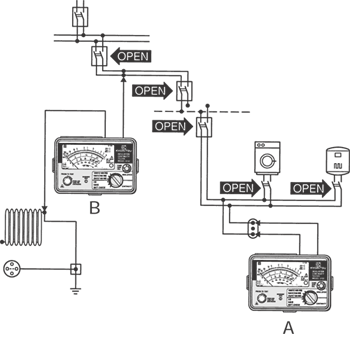Why insulation test is necessary?
All live conductors of electrical appliances and installations must be insulated to prevent electric shock hazards from inadvertent contact, fire hazards from short circuit and equipment damage. In addition, a low insulation resistance in installation will result in a leakage current, and hence causes a waste of energy which would increase the running costs of the installation.
| Nominal circuit voltage(V) | Test voltage V DC | insulation resistance (Mohms) |
|---|---|---|
| SELV and functional extra-low voltage, when the circuit is supplied from a safety isolating transformer (SELV:Safety Extra-Low Voltage) |
250 | >0.25 |
| Up to and including 500V with the exceptionof the above cases | 500 | >0.5 |
| Above 500V | 1000 | >1.0 |
Minimum value of insulation resistance by IEC364-6-61 TABLE 61A
Insulation resistance must be checked by applying appliances or installations a higher voltage than its normal working voltage, because an insulation resistance is lower at higher voltage than at lower voltage. KYORITSU's insulation resistance testers provide measurement at high levels of test voltages.
Periodical test is also important to ensure that insulation of installations or appliances is not deteriorating. Foreign matter and mechanical factors like wear or breakage may reduce insulation resistance. Regular tests and data logs can detect possible fault in insulation.
Insulation Testing Methods
- Measurement of Insulation resistance between live conductors (A)
Prior to testing, make sure that the circuit or part of the installation to be tested is disconnected from the mains supply and not energized.It is also necessary to ensure: the point of the installation to be checked is not open due to other equipment incorporated, the load connected with a fixed load and socket outlet is disconnected from the mains supply,and relay coils, fluorescent lamps, etc do not produce continuity between conductors. Circuits or components likely to be damaged by insulation test voltage must be removed from the circuit under test.If they cannot be disconnected, an alternative testing method is to measure insulation resistance between live conductors and earth. - Measurement of insulation resistance between live conductors and earth (B)
The test must be carried out with equipment always disconnected,i.e., with the mains switch open it must be disconnected from the mains supply. Earth terminal must be connected to earth and Line terminal to a live conductor or conductors.Where there is insulation deterioration or an indoor electrical installation is not partly or totally insulated a variety of electric hazards may be anticipated.

A-Between live conductors
B-Between live conductors and earth
To give some of the examples;
- Leakage current dangerous to the human body will develop.This is particularly the case with equipment that has no good earth and therefore is not properly protected against the potential difference.
- Overheating of conductors due to the leakage of current or microscopic discharging will cause short circuits or fires.
- RCDs will trip, with resulting damage to the equipment which will also cause short circuits and fires.
Kyoritsu's dedicated leakage clamp meters Model 2412, 2413F, 2431, 2432, 2433, 2433R, and 2434 will be very helpful in identifying the possible causes of such accidents.